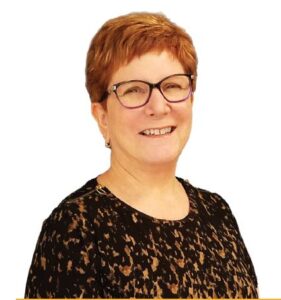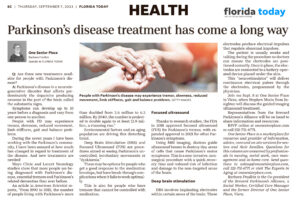

Barbara Fradkin – FLORIDA TODAY
Q: Are there new treatments available for people with Parkinson’s disease?
 A: Parkinson’s disease is a neurodegenerative disorder that affects predominately the dopamine producing neurons in the part of the brain called the substantia nigra. Symptoms can develop up to 10 years before a diagnosis and vary from one person to another. People with PD may experience tremor, slowness, reduced movement, limb stiffness, gait and balance problems.
A: Parkinson’s disease is a neurodegenerative disorder that affects predominately the dopamine producing neurons in the part of the brain called the substantia nigra. Symptoms can develop up to 10 years before a diagnosis and vary from one person to another. People with PD may experience tremor, slowness, reduced movement, limb stiffness, gait and balance problems.
During the seven years I have been working with the Parkinson’s community, I have been amazed at how much has changed in regard to treatment of the disease. And new treatments are needed! Mayo Clinic and Lancet Neurology studies show that more people are being diagnosed with Parkinson’s disease, essential tremors and Parkinson’s related dementias than ever before. An article in American Scientist reports, ” From 1990 to 2015, the number of people living with Parkinson’s more than doubled from 2.6 million to 6.3 million. By 2040, the number is projected to double again to at least 12.9 million, a stunning rise.” Environmental factors and an aging population are driving this disturbing trend.
Deep Brain Stimulation (DBS) and Focused Ultrasound (FUS) are procedures aimed at easing Parkinson’s uncontrolled, involuntary movements or “dyskinesia.” These may be options for people who get a good response to the medication levodopa, but have break-through complications when it fails to work optimally. This is also for people who have tremors that cannot be controlled with medication.
Focused Ultrasound
Thanks to research studies, the FDA in 2018 approved focused ultrasound (FUS) for Parkinson’s tremor, with expanded approval in 2021 for other Parkinson’s symptoms. Using MRI imaging, doctors guide ultrasound beams to destroy tiny areas of cells that cause Parkinson’s motor symptoms. This is a non-invasive, non-surgical procedure with a quick recovery time and reduced risk of infection and damage to the non-targeted areas of the brain.
Deep Brain Stimulation
DBS involves implanting electrodes within certain areas of the brain. These electrodes produce electrical impulses that regulate abnormal impulses. The patient is usually awake and talking during the procedure so doctors can ensure the electrodes are positioned correctly. Once in place, the electrodes are connected to a battery-operated device placed under the skin. This “neurostimulator” will deliver continuous electrical pulses through the electrodes, programmed by the physician.
Join me September 8th at One Senior Place in Viera, when Stephen Morio from Insightec will discuss the guided imaging ultrasound treatment. Representatives from the Brevard Parkinson’s Alliance will be on hand to share information and resources. RSVP online at OneSeniorPlace.com or call 321-751-6771.
One Senior Place is a marketplace for resources and provider of information, advice, care and on-site services for seniors and their families. Questions for this column are answered by professionals in nursing, social work, care management and in-home care. Send questions to askOSP@OneSeniorPlace.com, call 321-751-6771 or visit The Experts in Aging at OneSeniorPlace.com.
Barbara Fradkin is the Co-president of the Brevard Parkinson’s Alliance, a Social Worker, Certified Care Manager and the former Director of One Senior Place, Viera.


